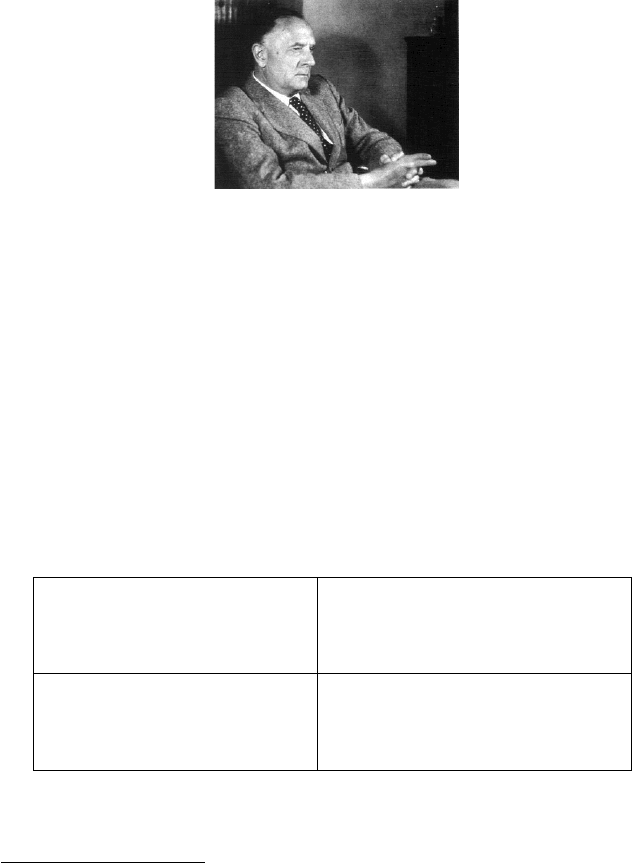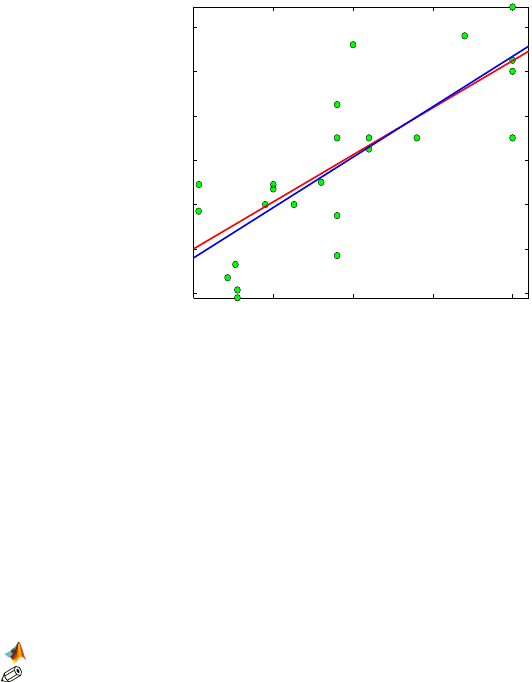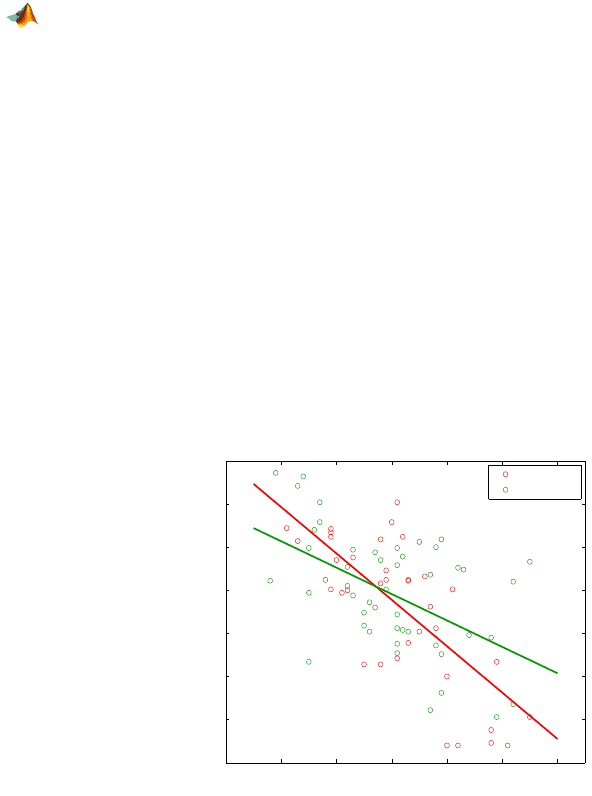Vidakovic B. Statistics for Bioengineering Sciences: With Matlab and WinBugs Support
Подождите немного. Документ загружается.


16.2 Simple Linear Regression 611
"
SSE
χ
2
n
−2,1−α/2
,
SSE
χ
2
n
−2,α/2
#
.
The following part of MATLAB script tests H
0
: σ
2
=0.5 versus H
1
: σ
2
<0.5
and finds a 95% confidence interval for
σ
2
. As is evident, H
0
is not rejected (p-
value 0.1981), and the interval is [0.2741,0.6583].
%test H
_
0: sigma2 = 0.5 vs H
_
1: sigma2 < 0.5
ch2 = SSE/0.5 %33.1981
ptst3 = chi2cdf(ch2, n-p) %0.1981
% Find 95% CI for sigma2
[SSE/chi2inv(0.975, n-p), SSE/chi2inv(0.025, n-p)]
% 0.2741 0.6583
16.2.1.4 Inference About the Mean Regression Response for x = x
∗
Suppose that the regression
ˆ
y = b
0
+b
1
x has been found and that we are inter-
ested in making an inference about the response y
m
=E(y|x = x
∗
) =β
0
+β
1
x
∗
.
The statistic for y
m
is
ˆ
y
m
= b
0
+b
1
x
∗
, and it is a random variable since both
b
0
and b
1
are random variables.
The
ˆ
y
m
is an unbiased estimator of y
m
, E
ˆ
y
m
=E(b
0
+b
1
x
∗
) =β
0
+β
1
x
∗
= y
m
,
as expected. The variance of
ˆ
y
m
is obtained from representation
ˆ
y
m
= b
0
+
b
1
x
∗
= y+b
1
(x
∗
−x) and the fact that the correlation between y and b
1
is zero:
Var
ˆ
y
m
=σ
2
µ
1
n
+
(x
∗
−x)
2
S
xx
¶
.
Thus,
ˆ
y
m
∼N
µ
β
0
+β
1
x
∗
,σ
2
µ
1
n
+
(x
∗
−x)
2
S
xx
¶¶
,
from which we develop the inference.
The test
H
0
: y
m
= y
0
relies on the statistic
t
=
ˆ
y
m
− y
0
s
q
1
n
+
(x
∗
−x)
2
S
xx
.

612 16 Regression
This statistic under H
0
has a t-distribution with n −2 degrees of freedom and
testing is done as in the cases of
β
0
and β
1
.
The (1 −α)100% confidence interval for y
m
=β
0
+β
1
x
∗
is
"
ˆ
y
m
−t
n−2,1−α/2
s
s
1
n
+
(x
∗
−x)
2
S
xx
,
ˆ
y
m
+t
n−2,1−α/2
s
s
1
n
+
(x
∗
−x)
2
S
xx
#
.
16.2.1.5 Inference About a New Response for x
= x
∗
Suppose that the regression
ˆ
y = b
0
+b
1
x has been established and that we
are interested in predicting the response
ˆ
y
pred
for a new observation, cor-
responding to a covariate x
= x
∗
. Given the value x = x
∗
, the difference be-
tween the inference about the mean response y
m
discussed in the previous
section and the inference about an individual outcome y
pred
is substantial.
As in the previous subsection,
ˆ
y
pred
= b
0
+ b
1
x
∗
, and the mean of
ˆ
y
pred
is
E(
ˆ
y
pred
) =β
0
+β
1
x
∗
= y
pred
, which is in fact equal to y
m
.
Where y
pred
and y
m
differ is their variability. The variability of
ˆ
y
pred
has
two sources, first, the variance of the distribution of ys for x
= x
∗
, which is
σ
2
, and second, the variance of sampling distribution for b
0
+b
1
x
∗
, which is
σ
2
³
1
n
+
(x
∗
−x)
2
S
xx
´
. Thus, Var (
ˆ
y
pred
) = MSE +Var (
ˆ
y
m
).
The distribution for
ˆ
y
pred
is normal,
ˆ
y
pred
∼N
µ
β
0
+β
1
x
∗
,σ
2
µ
1 +
1
n
+
(x
∗
−x)
2
S
xx
¶¶
,
and the subsequent inference is based on this distribution.
The test
H
0
: y
pred
= y
0
relies on the statistic
t
=
ˆ
y
pred
− y
0
s
q
1 +
1
n
+
(x
∗
−x)
2
S
xx
.
This statistic under H
0
has a t-distribution with n −2 degrees of freedom,
which implies the inference.

16.2 Simple Linear Regression 613
The (1 −α)100% confidence interval for y
pred
is
"
ˆ
y
pred
−t
n−2,1−α/2
s
s
1 +
1
n
+
(x
∗
−x)
2
S
xx
,
ˆ
y
pred
+t
n−2,1−α/2
s
s
1 +
1
n
+
(x
∗
−x)
2
S
xx
#
.
% predicting y for the new observation x, CI and PI
newx = 230; %Deficit = 230
y
_
newx = b0 + b1
*
newx % 16.5195
sym = s
*
sqrt(1/n + (mean(x) - newx)^2/SXX )
%st.dev. for mean response, sym = 3.2839
syp = s
*
sqrt(1 + 1/n + (mean(x) - newx)^2/SXX )
%st.dev. for the prediction syp = 3.3450
alpha = 0.05;
%mean response interval
lbym = y
_
newx - tinv(1-alpha/2, n-p)
*
sym;
rbym = y
_
newx + tinv(1-alpha/2, n-p)
*
sym;
% prediction interval
lbyp = y
_
newx - tinv(1-alpha/2, n-p)
*
syp;
rbyp = y
_
newx + tinv(1-alpha/2, n-p)
*
syp;
% the intervals
[lbym rbym] % 9.8875 23.1516
[lbyp rbyp] % 9.7642 23.2749
Next, we will find Bayesian estimators of regression parameters in the
same example, Diabetes Mellitus in Children, by using WinBUGS. On p. 606
we mentioned that taking x
i
−x as a predictor instead of x
i
is beneficial in the
Bayesian context. From such a parametrization of regression,
y
i
=β
∗
0
+β
1
(x
i
−x) +²
i
,
the traditional intercept
β
0
is easily obtained as β
∗
0
−β
1
x.
model{
for (i in 1:ntotal){
y[i] ~ dnorm( mui[i], tau )
mui[i] <- bb.0 + b.1
*
(x[i] - mean(x[]))
yres[i] <- y[i] - mui[i]
}
bb.0 ~ dnorm(0, 0.0001)
b.0 <- bb.0 - b.1
*
mean(x[])
b.1 ~ dnorm(0, 0.0001)
tau ~ dgamma(0.001, 0.001)
s <- 1/sqrt(tau)
}
DATA

614 16 Regression
list(ntotal=43,
y = c(4.8, 4.1, 5.2, 5.5, 5.0, 3.4, 3.4, 4.9, 5.6, 3.7,
3.9, 4.5, 4.8, 4.9, 3.0, 4.6, 4.8, 5.5, 4.5, 5.3,
4.7, 6.6, 5.1, 3.9, 5.7, 5.1, 5.2, 3.7, 4.9, 4.8,
4.4, 5.2, 5.1, 4.6, 3.9, 5.1, 5.1, 6.0, 4.9, 4.1,
4.6, 4.9, 5.1),
x = c(-8.1, -16.1, -0.9, -7.8, -29.0, -19.2, -18.9, -10.6,
-2.8, -25.0, -3.1, -7.8, -13.9, -4.5, -11.6, -2.1,
-2.0, -9.0, -11.2, -0.2, -6.1, -1.0, -3.6, -8.2,
-0.5, -2.0, -1.6, -11.9, -0.7, -1.2, -14.3, -0.8,
-16.8, -5.1, -9.5, -17.0, -3.3, -0.7, -3.3, -13.6,
-1.9, -10.0, -13.5))
INITS
list(bb.0 = 0, b.1 = 0, tau=1)
The output is given in the table below. It contains Bayesian estimators b.0
for β
0
and b.1 for β
1
. In the least-squares regression we found b
1
= S
xy
/S
xx
=
0.0494, b
0
= y−b
1
·x =5.1494, and s =
p
MSE =0.6363. Since priors were non-
informative, we expect that Bayesian estimators will be close to the classical.
Indeed that is the case:
b.0 = 5.149, b.1 = 0.0494, and s = 0.6481.
The classical standard errors of estimators for
β
0
and β
1
are sb0 = 0.1484
and sb1 = 0.0138, while the corresponding Bayesian estimators are 0.1525
and 0.01418.
The classical 95% confidence interval for
β
1
was found to be [0.0216,0.0773].
The Bayesian 95% credible set for
β
1
is [0.02139,0.07733], as is evident from
val2.5pc and val97.5pc in the output below.
mean sd MC error val2.5pc median val97.5pc start sample
b.0 5.149 0.1525 3.117E-4 4.848 5.149 5.449 2001 200000
b.1 0.0494 0.0141 3.072E-5 0.02139 0.04944 0.07733 2001 200000
s 0.6481 0.0734 1.771E-4 0.5236 0.6415 0.811 2001 200000
yres[1] 0.05111 0.09944 2.175E-4 -0.1444 0.05125 0.2472 2001 200000
yres[2] -0.2537 0.1502 3.459E-4 -0.5499 -0.2533 0.0418 2001 200000
yres[3] 0.09544 0.1431 2.925E-4 -0.1861 0.09505 0.378 2001 200000
yres[4] 0.7363 0.09957 2.167E-4 0.5406 0.7364 0.9325 2001 200000
...
yres[41] -0.4552 0.1333 2.727E-4 -0.7173 -0.4555 -0.1919 2001 200000
yres[42] 0.245 0.1028 2.314E-4 0.04251 0.2451 0.4475 2001 200000
yres[43] 0.6179 0.125 2.879E-4 0.3718 0.6179 0.8632 2001 200000
Thus, the Bayesian approach to regression estimation is quite close to the
classical when the priors on
β
0
and β
1
and the precision τ =1/σ
2
are noninfor-
mative.
Example 16.2. Hubble Telescope and Hubble Regression. Hubble’s con-
stant (H) is one of the most important numbers in cosmology because it is
instrumental in estimating the size and age of the universe. This long-sought
number indicates the rate at which the universe is expanding, from the pri-
mordial “Big Bang.” The Hubble constant can be used to determine the intrin-
sic brightness and masses of stars in nearby galaxies, examine those same

16.2 Simple Linear Regression 615
properties in more distant galaxies and galaxy clusters, deduce the amount of
dark matter present in the universe, obtain the scale size of faraway galaxy
clusters, and serve as a test for theoretical cosmological models.
Fig. 16.4 Edwin Powell Hubble (1889–1953).
In 1929, Edwin Hubble
1
(Fig. 16.4) investigated the relationship between
the distance of a galaxy from the Earth and the velocity with which it ap-
pears to be receding. Galaxies appear to be moving away from us no matter
which direction we look. This is thought to be the result of the “Big Bang.”
Hubble hoped to provide some knowledge about how the universe was formed
and what might happen in the future. The data collected included distances
(megaparsecs
2
) to n =24 galaxies and their recessional velocities (km/sec).
Hubble’s law is as follows: Recessional velocity = H
× distance,
where H is Hubble’s constant (units of H are [km/sec/Mpc]). By working back-
ward in time, the galaxies appear to meet in the same place. Thus 1/H can be
used to estimate the time since the Big Bang – a measure of the age of the
universe.
Distance in megaparsecs ([Mpc]) 0.032 0.034 0.214 0.263 0.275 0.275
0.45 0.5 0.5 0.63 0.8 0.9
0.9 0.9 0.9 1.0 1.1 1.1
1.4 1.7 2.0 2.0 2.0 2.0
Recessional velocity ([km/sec]) 170 290 −130 −70 −185 −220
200 290 270 200 300 −30
650 150 500 920 450 500
500 960 500 850 800 1090
A regression analysis seems appropriate; however, there is no intercept
term in Hubble’s law. Can you verify that the constant term of the regression
analysis is not significantly different than 0 at any reasonable
3
level of α. Find
1
Edwin Powell Hubble (b. Nov. 20, 1889, Marshfield, Missouri, U.S., d. Sept. 28, 1953, San
Marino, California.), American astronomer who is considered the founder of extragalactic
astronomy and who provided the first evidence of the expansion of the universe.
2
1 parsec = 3.26 light years
3
Reasonable here means level α not larger than 0.10

616 16 Regression
the 95% confidence interval for the slope β
1
, also known as Hubble’s constant
H, from the given data.
The age of the universe as predicted by Hubble (in years) is about 2.3 bil-
lion years.
0 0.5 1 1.5 2
−200
0
200
400
600
800
1000
Velocity (km/s)
Distance (mps)
Fig. 16.5 Hubble’s data and regression fits. The blue line is an unconstrained regression
(with intercept fitted), and the red line is a no-intercept fit. The slope for the no-intercept fit
is b
1
=423.9373 (=H).
%H = 423.9373
secinyear =60
*
60
*
24
*
365 %31536000
kminmps = 3.08568025
*
10^19;
age = 1/H
*
kminmps/secinyear %2.3080e+009
Modern measurements put H at approx. 70, thus predicting the age of the
universe to about 14 billion years.
Figure 16.5 showing Hubble’s data and regression fits is generated by
hubble.m.
16.3 Testing the Equality of Two Slopes*
Let (x
1i
, y
1i
), i =1,..., n
1
and (x
2i
, y
2i
), i =1,..., n
2
, be the pairs of measure-
ments obtained from two groups, and for each group the regression is esti-
mated as
y
1i
= b
0(1)
+b
1(1)
x
1i
+e
i(1)
, i =1,.. . , n
1
, and
y
2i
= b
0(2)
+b
1(2)
x
2i
+e
i(2)
, i =1,.. . , n
2
,

16.3 Testing the Equality of Two Slopes* 617
where in groups i = 1,2 the statistics b
0(i)
and b
1(i)
are estimators of the re-
spective population parameters, intercepts
β
0(i)
, and slopes β
1(i)
. We are inter-
ested in testing the equality of the population slopes,
H
0
: β
1(1)
=β
1(2)
,
against the one- or two-sided alternatives.
The test statistic is
t
=
b
1(1)
−b
1(2)
s.e.(b
1(1)
−b
1(2)
)
, (16.2)
where the standard error of the difference b
1(1)
−b
1(2)
is
s.e.(b
1(1)
−b
1(2)
) =
s
s
2
·
1
S
xx(1)
+
1
S
xx(2)
¸
,
and s
2
is the polled estimator of variance,
s
2
=
SSE
1
+SSE
2
n
1
+n
2
−4
.
Statistic t in (16.2) has a t-distribution with n
1
+n
2
−4 degrees of freedom
and, in addition to testing, could be used for a (1
−α) 100% confidence interval
for
β
1(1)
−β
1(2)
,
[(b
1(1)
−b
1(2)
) ∓t
n
1
+n
2
−4,1−α/2
×s.e.(b
1(1)
−b
1(2)
)].
Example 16.3. Cadmium Poisoning. Chronic cadmium poisoning is an in-
sidious disease associated with the development of emphysema and the excre-
tion in the urine of a characteristic protein of low molecular weight. The first
signs of chronic cadmium poisoning become apparent following a latent in-
terval after exposure has ended. Respiratory functions deteriorate faster with
in age. The data set featured in Armitage and Berry (1994) gives ages (in
years) and vital capacity (in liters) for 84 men working in the cadmium indus-
try,
cadmium.dat|mat|xlsx. The observations with flag exposure equal to 0
denote persons unexposed to cadmium oxide fumes, while flags 1 and 2 corre-
spond to exposed persons. The purpose of the study was to assess the degree
of influence of exposure to respiratory functions. Since respiratory functions
are influenced by age, regardless of exposure, age as a covariate needs to be
taken into account. Thus, the suggested methodology is to test the equality of
the slopes in group regressions of vital capacity to age:
H
0
: β
1(exposed)
=β
1(unexposed)
versus H
1
: β
1(exposed)
<β
1(unexposed)
.

618 16 Regression
The research hypothesis is that the regression in the exposed group is “steeper,”
that is, the vital capacity decays significantly faster with age. This corresponds
to a smaller slope parameter for the exposed group since in this case the slopes
are negative (Fig. 16.6). The inference is supported by the following MATLAB
code.
xlsread vitalcapacity.xlsx;
twos = ans;
x1 = twos( twos(:,3) > 0, 1); y1 = twos( twos(:,3) > 0, 2);
x2 = twos( twos(:,3) ==0, 1); y2 = twos( twos(:,3) ==0, 2);
n1=length(x1); n2 = length(x2);
SXX1 = sum((x1 - mean(x1)).^2) %4.3974e+003
SXX2 = sum((x2 - mean(x2)).^2) %6.1972e+003
SYY1 = sum((y1 - mean(y1)).^2) %26.5812
SYY2 = sum((y2 - mean(y2)).^2) %20.6067
SXY1 = sum((x1 - mean(x1)).
*
(y1 - mean(y1))) %-236.3850
SXY2 = sum((x2 - mean(x2)).
*
(y2 - mean(y2))) %-189.7116
b1
_
1 = SXY1/SXX1 %-0.0538
b1
_
2 = SXY2/SXX2 %-0.0306
SSE1 = SYY1 - (SXY1)^2/SXX1 %13.8741
SSE2 = SYY2 - (SXY2)^2/SXX2 %14.7991
s2 = (SSE1 + SSE2)/(n1 + n2 - 4) %0.3584
s = sqrt(s2) %0.5987
seb1b2 = s
*
sqrt( 1/SXX1 + 1/SXX2 ) %0.0118
t = (b1
_
1 - b1
_
2)/seb1b2 %-1.9606
pval = tcdf(t, n1 + n2 - 4) %0.0267
10 20 30 40 50 60 70
2.5
3
3.5
4
4.5
5
5.5
6
age (years)
VC (liters)
exposed
unexposed
Fig. 16.6 Samples from exposed (red) and unexposed (green) groups with fitted regression
lines. The slopes of the two regressions are significantly different with a p-value smaller
than 3%.

16.4 Multivariable Regression 619
Thus, the hypothesis of equality of slopes is rejected with a p-value of
2.67%.
Note. Since the distribution of t-statistic is calculated under H
0
, which
assumes parallel regression lines, the more natural estimator
s22, in place of
s2, takes into account this fact. The number of degrees of freedom in the t-
statistic changes to n
1
+n
2
−3. The changes in the inference are minimal, as
evidenced from the MATLAB code accounting for
s22.
%s22 accounts for equality of slopes:
s22 = (SYY1 + SYY2 - ...
(SXY1 + SXY2)^2/(SXX1 + SXX2))/(n1 + n2 - 3) %0.3710
s = sqrt(s22) %0.6091
seb1b2 = s
*
sqrt( 1/SXX1 + 1/SXX2 ) %0.0120
t = (b1
_
1 - b1
_
2)/seb1b2 %-1.9270
pval = tcdf(t, n1 + n2 - 3) %0.0287
For the case of the confidence interval, estimator s2 and n
1
+n
2
−4 degrees
of freedom should be used.
16.4 Multivariable Regression
It is often the case that in an experiment leading to regression analysis more
than a single covariate is available. For example, in Chap. 2, p. 31, we dis-
cussed an experiment in which two indices of the amount of body fat (Siri
and Brozek indices) were calculated from the body density measure. In ad-
dition, a variety of body measurements, including weight, height, adiposity,
neck, chest, abdomen, hip, thigh, knee, ankle, biceps, forearm, and wrist, were
recorded. Recall that the body density measure is complicated and potentially
unpleasant, since it is taken by submerging the subject in water. Therefore, it
is of interest to ask whether the Brozek index can be well predicted using the
nonintrusive measurements.
If x
1
, x
2
,... , x
k
are variables, covariates, or predictors, and we have n joint
measurements of covariates and the response, x
i1
, x
i2
,... , x
ik
, y
i
, i =1,2,..., n,
then multivariable regression expresses the response as a linear combination
of covariates, plus an intercept and an additive error:
y
i
=β
0
+β
1
x
i1
+β
2
x
i2
+···+β
k
x
ik
+²
i
, i =1,.. . , n.
The errors
²
i
are assumed to be independent and normal with mean 0 and
constant variance
σ
2
. We will denote by k the number of covariates, but the
number of parameters in the model is p
= k+1 because the intercept β
0
should
be added. To avoid confusion we will mostly use p – the number of parameters
in all expressions that involve dimensions and derived statistics.
As in the univariate case, we will be interested in estimating and test-
ing the coefficients, error variance, and mean and prediction responses. How-
620 16 Regression
ever, multivariable regression brings several new challenges when compared
to a simple regression. The two main challenges are (i) the possible presence
of multicollinearity among the covariates, that is, covariates being correlated
among themselves, and (ii) a multitude of possible models and the need to find
the best model by identifying the “best” subset of predictors. A synonym for
multivariable regression is multivariate regression, although the second term
is also used when the response y is multivariate, which is not the case here.
16.4.1 Matrix Notation
If the regression equations for all n observations (x
i1
, x
i2
,... , x
ik
, y
i
), i =1,.. . , n
are written as
y
1
= β
0
+β
1
x
11
+β
2
x
12
+···+β
k
x
1k
+²
1
,
y
2
= β
0
+β
1
x
21
+β
2
x
22
+···+β
k
x
2k
+²
2
,
.
.
.
y
n
= β
0
+β
1
x
n1
+β
2
x
n2
+···+β
k
x
nk
+²
n
,
then one can write the above system in convenient matrix form as
y
= Xβ +²,
where
y
=
y
1
y
2
.
.
.
y
n
,
X
=
x
1
x
2
.
.
.
x
n
=
1 x
11
x
12
··· x
1k
1 x
21
x
22
··· x
2k
.
.
.
.
.
.
1 x
n1
x
n2
··· x
nk
, β =
β
0
β
1
.
.
.
β
k
, and ² =
²
1
²
2
.
.
.
²
n
.
Note that y and
² are n×1 vectors, X is an n×p matrix, and β is a p×1 vector.
Here p
= k+1. To find the least-squares estimator of β, one minimizes the sum
of squares:
n
X
i=1
(y
i
−(β
0
+β
1
x
i1
+···+β
k
x
ik
))
2
.
